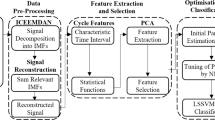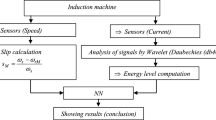Abstract
This paper proposes a method of fault diagnosis for non-stationary fault signals of rotating machinery based on ensemble empirical mode decomposition (EEMD) time-frequency energy and a self-organizing map (SOM) neural network. The method uses EEMD to decompose the fault signal, obtaining an Hilbert–Huang transform time-frequency spectrum based on all the intrinsic mode functions. The time-frequency plane is then segmented into several equal blocks, where the fault feature vector is composed of the energy of each block. All of the feature vectors of the training samples are then put into the SOM neural network to train the network. The output layer is clustered into several regions, with each region corresponding to a fault. Finally, new samples are added to the trained SOM network so faults are recognized according to regions based on the location of the output neuron. Experimental results indicate that this method can eliminate the mode-mixing problem and low-frequency false components that exist with EMDresults. Diagnosis accuracy with the proposed method is higher than what can be achieved using EMD, and the diagnostic results also have high visibility.

Similar content being viewed by others
References
Huang N.E., Shen Z., Long S.R.: The empirical mode decomposition and the Hilbert spectrum for nonlinear and non-stationary time series analysis. Proc. R. Soc. Lond. Ser. A: Math. Phys. Eng. Sci. 454, 903–995 (1998)
Qin T.L., Yang Y., Cheng H., Xue S.: Rolling bearing fault diagnosis based on intrinsic mode function energy moment and BP neural network. J. Vib. Meas. Diagn. 28, 229–232 (2008)
Li Q.W., Wang B.L., Huang Z.Y.: Flow pattern identification of oil-gas two-phase flow based on empirical mode decomposition and BP neural network. Chin. J. Sci. Instrum. 28, 609–613 (2007)
Zhang H.C., Wu W.W., Zheng X.J.: Fault diagnosis in gearb ox based on empirical mode decomposition and hilbert spectrum. Mach. Tool Hydraul. 35, 174–176 (2007)
Wu Z.H., Huang N.E.: Ensemble empirical mode decomposition: a noise-assisted data analysis method. Adv. Adapt. Data Anal. 1, 1–41 (2009)
Tang H.B., Wu Y.X., Hua G.J.: Internal leakage fault diagnosis of hydraulic cylinder using PCA and BP network. J. Central South Univ. (Sci. Technol.) 42, 3709–3714 (2011)
Wu J., Yang X.L.: Fuzzy BP neural network and its applications in fault diagnosis. Syst. Eng. Electron. 23, 73–75 (2001)
Wang Z., Ai Y.T., Sha Y.D.: Research on fault diagnosis technology of whole body vibration of aero-engine based on BP neural network. Chin. J. Sci. Instrum. 28, 168–171 (2007)
Kohonen T.: The self-organizing map. Proc. IEEE 78, 1464–1480 (1990)
Li Z.Y., Wu J.Y., Wu W.L.: Power customers load profile clustering using the SOM neural network. Autom. Electr. Power Syst. 32, 66–70 (2008)
Ren J., Su H.Y., Chu J.: Application of SOM-based data mining methods to PX absorption and separation process. Inf. Control 35, 84–89 (2006)
Niu Z.G., Zhang H.W., Xin Z.W.: Study on coastal water quality analysis by the SOM. Adv. Water Sci. 16, 569–573 (2005)
Hu A.J., Sun J.J., Xiang L.: Mode mixing in empirical mode decomposition. J. Vib. Meas. Diagn. 31, 429–434 (2011)
Zhao J.P.: Study on the effects of abnormal events to empirical mode de-composition method and the removal method for abnormal signal. J. Ocean Univ. Qingdao 31, 805–814 (2001)
Wang H., Zhang L.B., Wang Z.H.: Application of ISVD de-noising and reassigned spectrogram in HHT time-frequency spectrum analysis of flue gas turbine. Chin. J. Sci. Instrum. 30, 615–620 (2009)
Wu Z.H., Huang N.E.: A study of the characteristics of white noise using the empirical mode decomposition method. Proc. R. Soc. Lond. Ser. A: Math. Phys. Eng. Sci. 460, 1597–1611 (2004)
Flandrin P., Rilling G., Goncalves P.: Empirical mode decomposition as a filter bank. Signal Process. Lett. IEEE 11, 112–114 (2004)
Author information
Authors and Affiliations
Corresponding author
Rights and permissions
About this article
Cite this article
Wang, H., Gao, J., Jiang, Z. et al. Rotating Machinery Fault Diagnosis Based on EEMD Time-Frequency Energy and SOM Neural Network. Arab J Sci Eng 39, 5207–5217 (2014). https://doi.org/10.1007/s13369-014-1142-3
Received:
Accepted:
Published:
Issue Date:
DOI: https://doi.org/10.1007/s13369-014-1142-3




